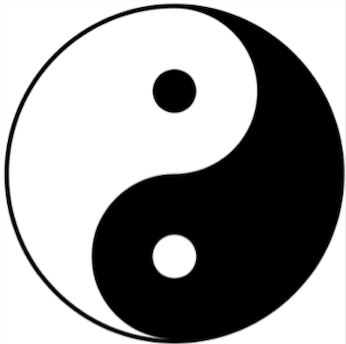By Bernie Clark, August 7th, 2020

Finding nuance in a black and white world.
Most lovers of Yin Yoga are familiar with the taijitu symbol: a dark fish becomes light and a white fish moves back into darkness. At first glance, the icon seems to depict the world as purely black and white, but a closer look reveals many reflections of reality. There is a black dot within the white swirl and vice versa. There is nuance to be found within a seemingly black and white world. Where there appears to be one, two arises. Where there appears to be two, many things are found:[1]
The Dao created one.
One created two,
Two created three,
And three brought into being the ten thousand things.
The ten thousand things carry yin and embrace yang.
They achieve harmony by balancing these forces.
The Dao means “the way” and points to the way things are; the way the universe works; the way to harmony within this world. Harmony is not achieved by following a binary, black or white map, but rather through seeing the relationships between darkness and light. Neither is supreme nor ideal: both have value, but only as a contrast, not an absolute.
In a world riven by social media angst and outrage, it is easy to get swept up into the binary, to be driven by extremes, by an either/or mentality—either you agree with me, or I cannot talk to you. This is not new, but it has certainly become more prevalent and malevolent. There are many harsh lines drawn between extremes: you are either for vaccinations or an anti-vaxxer—there is no room for a middle view. Either wearing a COVID-19 mask marks you as a tool of the oppressors or a caring citizen looking after the health of the vulnerable. Either you have taken the blue pill and chosen security over knowledge or swallowed the red pill and awoken to painful reality. However, beyond all these dichotomies there can be found a gray world of deeper nuance, if we would but seek it.
Red Pill or Blue Pill?
To take just one example: the blue versus red pill meme of the Matrix movies. On the surface the choices seem very binary. Either you choose to awaken to a greater reality beyond your everyday senses and see what is real (the red pill), or you choose to remain blissfully ignorant but completely at the mercy of the machine (the blue pill).[2] Where is the nuance in that? In the blue pill world, you are reliant upon your senses to guide you, to show you reality. In the red pill world, you realize that the blue pill world is a simulation—the Matrix. Your mind was deceived: your senses illusory.
But there are shades of gray even here. If you truly believe in the red pill world, that your previous experiences were unreal because you were caught in a simulation, then how can you be sure that this new view of reality is any more correct than your previous view? Perhaps you may need a new pill, a green pill, to help you awaken to a deeper view: a view that the red pill world is but another layer of simulation from which you need to awaken. Once you admit that your senses are unreliable and cannot show you reality, then even in the red pill world you cannot rely upon your senses to know what is real. Nor in the green pill world, or any other world you awaken to. If there is one simulation, then you must admit there can be many simulations nested within simulations. How can you ever know if you have reached reality? The red pill is rife with nuances.
Additionally, what seems to be ignored by red pill lovers is—the Matrix is a movie! It is not real. Neo is not a real person: he is played by an actor and is no more real than Ted Theodore Logan.[3] The lost irony of the movie is that we should not trust illusions, but the movie itself is just such an illusion and thus should not be trusted.
At the other extreme, if you believe that reality is only to be found in the blue pill world, where our senses do convey a facsimile of reality, there are also nuances. Our senses are not perfect: they often fool us. Of course we have far more than five senses: we are proprioceptive; interoceptive; we can sense time passing; we have conceptual senses such as a sense of fair play and a sense of honor; etc. But we cannot sense X-rays or dark matter. While we can remember the past and guess the future, we can sense neither. Our senses in the blue pill world do not give us a complete picture of reality. There are blue pill nuances too.
Seeking nuance
Whenever we are presented with a binary choice, a reasonable reaction can be skepticism. Where is the nuance? Nothing is purely black or white (including this statement!). Any view taken to extreme loses nuance. The center cannot hold.[4] Walls are erected to prevent deeper enquiry. Balance is denied and any attempts to present a middle ground are seen as a threat or a delusion. One person’s binary view of Daoist philosophy insists that coffee is yin because it is so dark in color. Another person rejects this view and insists coffee is yang because it is so hot. Nuance suggests coffee can be both yin and yang because it is both dark and hot.
The world of yoga is not immune and, indeed, seems to be an incubator for binary views. Dogmatism is the inevitable daughter of darkness: an insistence on the one right way, which means all other ways are wrong. No questions are suffered. No proof is required. Only obedience suffices. Students are warned, “Do it this way because this is the way it has been taught.” Or, “There is one and only one correct alignment for every pose and for everybody.” Students come to fear that any variance of these directives risks injury and estrangement.
Binary yoga instructions
Whenever a yoga teacher proclaims “never” or “always,” remember this mantra: “Never is never right; always is always wrong.”[5] The commands to always keep a microbend in your knees, to never hyperextend your shoulder, to always have your feet parallel to each other and to never allow your hands to move wider apart than shoulder width are binary. They imply that there is a right way and a wrong way to move and place your body that only the teacher knows. Your own experience is irrelevant. One implication, often unstated, is that since too much stress is potentially dangerous, then the only option is to seek no stress. Sometimes these absolutes are hidden within another word: “should.” If you ignore this auxiliary verb, you risk injury and pain. A binary choice has been presented with no option of debate, discussion or determining a middle ground.
In a black and white world your only choices are to submit or leave: again, the binary. But, the more you submit, the more difficult it is to remit. Eventually, you forget that you even have the choice. All options are closed. This is true whether you inhabit an all-light world or an all-dark one. However, if you remember to seek nuance, the world opens again.
Nuance is looking for the white dot in the midst of darkness. Nuance is asking of your own beliefs, “what if…?”, “yes, but…!”, “couldn’t it be…?” Nuance allows you to face someone in the heart of a black or white swirl and see beyond the words they utter, to the person who utters. What reasons do they have to avow their views? Choosing ridicule and even logic to dissuade them will create a distance and a barrier between you. Nuance lowers walls and allows space to consider and engage, rather than prejudge and dismiss. There are always deeper levels to plumb in any worldview.
Of course, it is not always possible or even desirable to change another person’s view. Many people hold fast to their worldviews and brook no questions, no discussions, no responses. That does not mean that you have to emulate this attitude. Raising objections to their beliefs, citing logic or casting ridicule will not sway them. Seeking nuance does not have such objectives. Seeking nuance can ask why they hold these views, not merely how to change them. Discourse can be engaged by asking, “Interesting! Please tell me how you came to believe this to be so?” We seek to understand the personal process whereby the worldview was adopted, not the particular logic of the view itself.
Once the process is known, then it may be possible to follow the same process to develop a more nuanced view. Subtle possibilities could be pointed out that are more or less consistent with the worldview, but show some shades of gray. Once a hint of gray is perceived, then the world is already not purely black or white. To return to the red pill analogy: using the principle already agreed upon that our senses do not show us reality and can be deceived, it is plausible that we are being manipulated again in the red pill world. Now the worldview is not the binary red versus blue view, but other colors can be, indeed have to be, considered.
When certainty is diminished and an “I don’t know” mentality is re-found, possibilities expand. This is the joy in science: discovering the areas where the data do not fit the model. The challenge is taken up to create new maps. Dogmatic assertions do not serve us well, but a freedom to discuss alternatives and see various points of view will help us to open to nuance. Nothing is ever black or white. Beware the binary.
____________________________
[1] This quote is from the ancient teachings of the Dao de Jing by Lao Tzu, chapter 42.
[2] This is a view found in many philosophies and religions as well: the mind is real and the physical realm is an illusion. Spirit and matter are absolutely distinct and binary, as predicted by Cartesian principles.
[3] Keanu Reeves fans will surely remember the role he played in the movie Bill and Ted’s Excellent Adventure, where a time-travelling Rufus helps Bill and Ted complete their history project. (I wish George Carlin’s time machine could bring him back to us today! His wisdom is missed.)
[4] This is a phrase from the poem The Second Coming by William Butler Yeats, written following the 1918–1919 pandemic in which Yeats’ pregnant wife caught the virus and nearly died.
Turning and turning in the widening gyre
The falcon cannot hear the falconer;
Things fall apart; the centre cannot hold;
Mere anarchy is loosed upon the world,
The blood-dimmed tide is loosed, and everywhere
The ceremony of innocence is drowned;
The best lack all conviction, while the worst
Are full of passionate intensity.
https://www.poetryfoundation.org/poems/43290/the-second-coming
[5] I first heard this saying from Paul Grilley, but I am not sure who actually coined the phrase. Ironically, this statement applies to itself as well!
